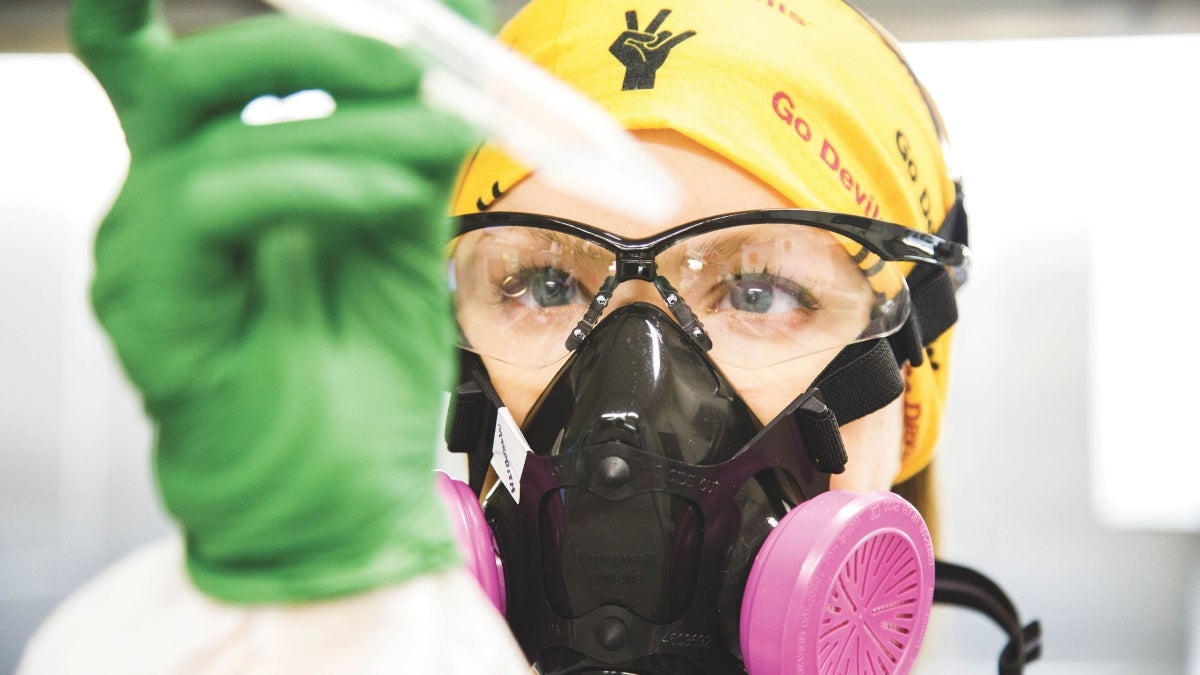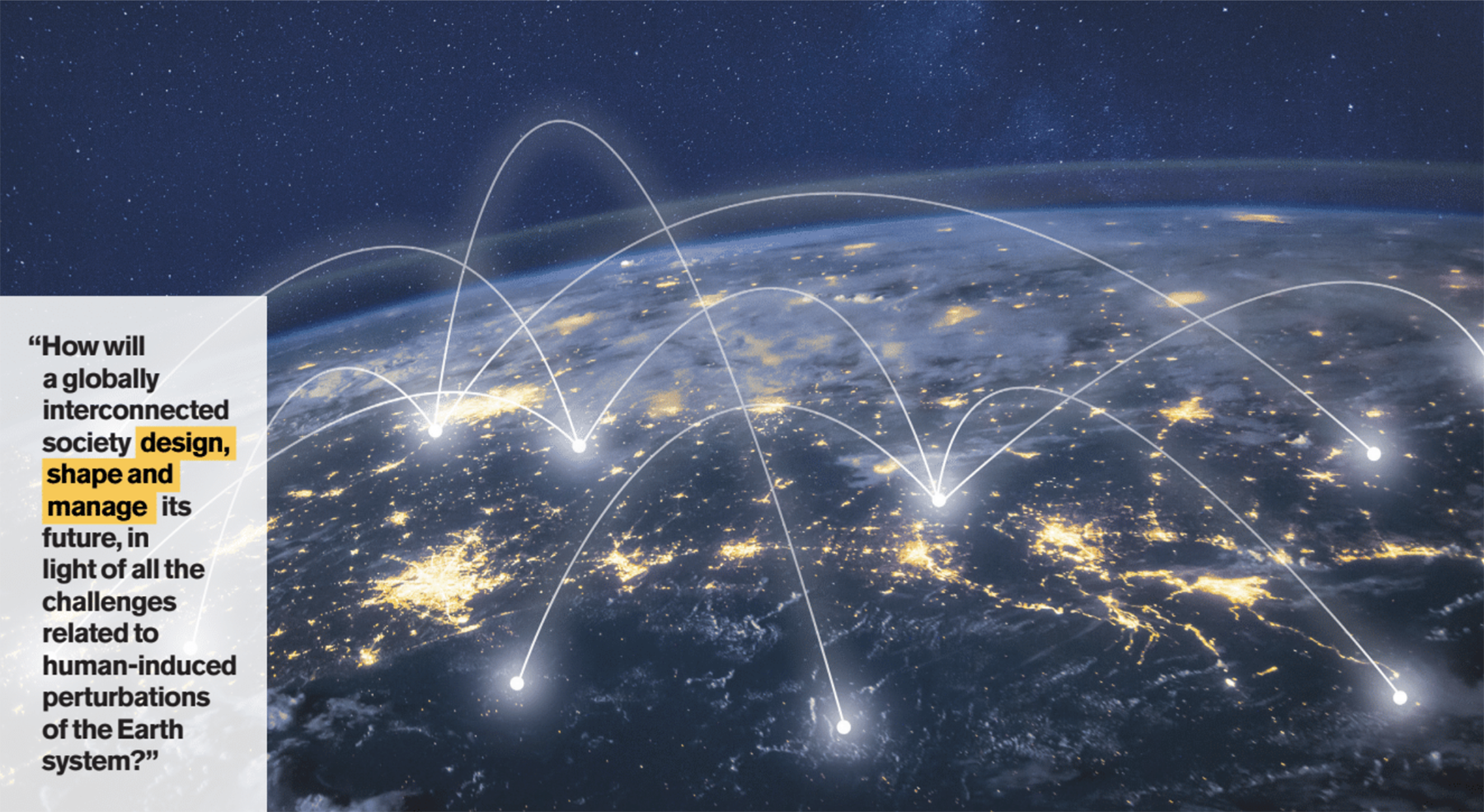Editor's note: This story originally appeared in the summer 2020 issue of ASU Thrive magazine.
This article is presented by Arizona State University's Global Futures Laboratory, co-authored by Peter Schlosser, Manfred Laubichler, Clea Edwards, Steven Beschloss, Nina Berman, Sander van der Leeuw, Joni Adamson, Michael Barton, Mark Bernstein, Shauna BurnSilver, Gary Dirks, Jason Franz, Nico M. Franz, Nancy B. Grimm, Julianna Gwiszcz, Deborah Helitzer, Carrie Lloyd, Kathleen Merrigan, Osvaldo Sala, Christopher Wharton and Dave White.
COVID-19 must be seen as the largest shock that has hit global society since World War II, spreading disease resulting in an accelerating loss of lives and societal and economic disruptions of staggering proportions. This global pandemic brings into stark relief the increasingly complex, interconnected and vulnerable systems that define the modern world. The world’s population was patently unprepared for COVID-19. We knew from previous pandemics that it was only a matter of time before we would be hit by another. Although the exact time and location of these events remain unpredictable, science had suggested how to prepare for such a shock.
COVID-19 hit global society like an earthquake, and like an earthquake, we can expect it to happen again, but cannot predict when. This places extreme hardship on most people on our planet because there is little time to respond with potential for significant loss of human life. Here, we focus on the connection of this crisis to another that is steadily building, although more slowly and on longer time scales: How will a globally interconnected society design, shape and manage its future, in light of all the challenges related to human-induced perturbations of the Earth system?
Possible trajectories of global futures will depend crucially on how the globally interconnected Earth system, including the human domain, can withstand and respond to: (a) known and ongoing changes that frequently occur on long time scales, and (b) shocks that can be anticipated in principle, but whose timing and impacts cannot be predicted. An example of the former are unfolding changes in the climate system and their consequences, including migration, biodiversity loss, sea-level rise, etc. COVID-19 falls into the latter category. This raises the fundamental question: What do we know about the basic dynamics of the globally interconnected Earth system and its resilience to shocks?
The ultimate stress test
If one was asked to design a stress test to evaluate the current capacity of the Earth system to respond to shocks, the current pandemic could be viewed as the ultimate design. Although such stress tests are not perfect, they offer valuable information on the state of a system, and can guide the enhancement of its resilience to perturbations and/or shocks.
A virus, such as the one that spawned COVID-19, hits at the heart of all human interactions including social contact and behavior. A new virus, with no known treatments or vaccines plus the additional challenge of a very long incubation time, means that the traditional functions of health care systems — treating illness and making vaccinations available to the population for prevention — do not work. This situation then tests if other societal structures and actions can substitute for the absence of the primary measures that should have buffered the impact of a particular shock, such as COVID-19. Our health systems find themselves in a position of earlier centuries: merely able to care for the sick and isolate the rest of the population. So-called social distancing is the modern equivalent of closed medieval city walls.
Shutdown of all but essential business has caused mass unemployment. Projections are that the economy could shrink by 20% to 30% or more. The size of the needed financial rescue packages grows by the day and will soon surpass state annual budgets or even their annual GDP. Supply chains are disrupted or approach disarray. Anxiety levels are skyrocketing with a real danger of elevated levels of domestic violence and child abuse. It may be only a matter of time until social unrest challenges the power structures struggling to contain the pandemic. These impacts of the pandemic, which rapidly affect the functioning of virtually all parts of the Earth system, raise the central question: Why are our societies not better prepared to respond to such shocks?
Human preparedness and response to shocks
Viruses do not discriminate based on rich or poor, but people who have greater access to financial resources and/or are part of societies with a developed social safety net are better equipped to respond to disruptions such as COVID-19. Many families depend on the income of low-wage laborers whose jobs require them to show up. As a double impact, those jobs put them at the greatest risk of contracting a virus; not only do their jobs lack a work-from-home option, they require human contact. These families are the least likely to afford alternative child care options or medical care to allow them to tend to a sick family member. In the U.S., paid sick leave is available very unevenly, and among those who have health insurance, many have prohibitively high deductibles that influence decisions to seek testing or treatment.
Historically, pandemics have caused widespread change across social, economic, political and cultural spheres. The pandemics across the Americas that were brought on by European settlers bolstered the colonizers’ conquest of land and peoples. The Black Death of the 14th century killed between 75 to 200 million people across Europe and Asia, including approximately 30% to 60% of Europe’s population. It had traveled along the Silk Road, thus highlighting the early modern connection between economic and social networks. The loss of life destabilized feudalism, saw rising wages in response to labor shortages and led to reforestation as a result of vacant land.
Similarly, the consequences for global supply chains and the financial systems have repeatedly been modeled. Why does humankind once again find itself unprepared, ignoring necessary actions to mitigate known problems and bolster response systems?
This current global pandemic resembles climate change. But, unlike the consequences of climate change that will play out most dramatically in a few decades, the systemic shocks we are experiencing offer the chance to rebuild and redesign the system. The question is: Can we get it right? Can we design systems with the necessary adaptive capacity that decrease the likelihood of pandemics and allow us to react more swiftly and effectively to unpredictable outbreaks?
Underlying complexity
Understanding if societies are prepared for shocks such as the one COVID-19 presents requires knowledge of the system-level properties that govern these interconnected systems. What matters most are the varied consequences of positive and negative feedback relations in complex systems. Negative feedback exerts regulatory control by keeping systems within certain bounds, while positive feedback allows systems to grow and exploit opportunities. But negative feedback can also lead to stagnation and intransigence while positive feedback can initiate uncontrolled, runaway effects. Both are clearly important in all complex systems, and those systems that find the right balance are the ones that thrive.
Over the last centuries, most globally interconnected systems have emphasized positive feedback mechanisms by prioritizing innovation cascades. This has led to the ever-accelerating dynamics of globalization and the Anthropocene. Consequentially, this resulted in large numbers of unintended consequences. As certain societies came to value these advances, many nations removed or weakened the negative feedback loops and regulatory functions that kept the dynamics of global society in balance. This created the current deregulated system of our globalized economy and supply chains, fueled by a huge and more deregulated financial system.
The response to this pandemic is an attempt to set up regulatory controls and negative feedback mechanisms at different scales. Mostly, this means setting up boundaries such as isolation and quarantine measures at local, regional and national levels in the hope that people follow the regulations. We now confront significant trade-offs and consequences for national and global economies and public health, as well as individual and social well-being. These actions also expose the lack of adequate institutions at the systems level — that is, global organizations to provide global governance to the global crisis.
What does the COVID-19 stress test show so far?
If we treat this pandemic as a stress test and observe and rank current responses, we see mostly failure. Failure at the highest levels to prepare for such an outbreak, despite scientific models and lessons from history. Failure to rethink human relationships to wild and domesticated animals. Failure in the nature, timing and scale of the response. Failure to anticipate, and therefore prepare, for the vast array of consequences that such a disruption causes across the tightly interconnected elements of the Earth system. And finally, failure to prepare long-term scenarios that could mitigate the most harmful consequences of immediate actions.

Peter Schlosser is the vice president and vice provost of the Global Futures Laboratory at ASU. The laboratory has been launched to advance ASU’s deep commitment to use-inspired research, its ongoing work in sustainability and service to the global community in which we live.
Now that governments are responding with drastic measures to slow the rate of new cases in order to give overwhelmed health care systems a fighting chance, the ripple effects throughout all aspects of social and economic life are growing exponentially. Among them: rising unemployment, decrease in demand and dramatic drops in economic activities, lack of child care and missing school meals, existential threats to key industries such as airlines, not to speak of the effects of increasing social isolation. A scenario where these measures would have to be in place for more than a year — the most optimistic estimate for the availability of a vaccine — seem unimaginable. This may play out more severely in places with weak health care systems, such as in less-developed countries. With no global governance and a delayed and ineffectual response in several important nations, we remain stuck without plans for an exit strategy.
Opportunities for optimal future responses
In order to be effective, the suppression and mitigation measures will have to be highly coordinated across the whole spectrum, from local to global. This includes fully transparent information flows and data sharing, the strategic deployments of resources, planned coordinated interventions to support economic activities and triage at all scales. The whole set of responses will have to be guided by strong institutions devoted to shared values and guided by common principles. The fact that nations have radically different political and economic systems — that the world has become more polarized and with more inequality — makes coordination more difficult, but also more necessary.
Viruses are transboundary problems, and thus are an expression of our global interconnectivity. This could be an opportunity to overcome anachronistic nationalistic behavior in favor of global solidarity, inviting transparency and a shared sense of humanity. As a species, we have chosen economic globalization again and again in varying forms for thousands of years, from the days of the Silk Road and colonial trading networks to today’s teleconnected planet. Presently, our system of global interactions is designed primarily to reap the benefits of global trade but retreats into a nationalistic frame in times of crisis. Perhaps we are at a crossroads that highlights that economic benefits cannot be separated from social responsibilities.
Even the initial responses to COVID-19 suggest that all societies may be willing to respond in ways that have not been seen outside of wartime. But what of coming threats to global futures for all of humanity? Are we willing to confront these with the same sense of urgency, even though the main consequences will be in the future and might not directly affect the majority of those currently making decisions? The answer from the global community, indeed from each of us, will determine whether we only address immediate impacts or recognize the present crisis is an opportunity to design long-term strategies that ensure the healthy, interconnected survival of the human species and our planet.
Top photo by Felipe Esquivel Reed.
More Health and medicine

New study seeks to combat national kidney shortage, improve availability for organ transplants
Chronic kidney disease affects one in seven adults in the United States. For two in 1,000 Americans, this disease will advance to kidney failure.End-stage renal failure has two primary…

New initiative aims to make nursing degrees more accessible
Isabella Koklys is graduating in December, so she won’t be one of the students using the Edson College of Nursing and Health Innovation's mobile simulation unit that was launched Wednesday at Arizona…

Reducing waste in medical settings
Health care saves lives, but at what cost? Current health care practices might be creating a large carbon footprint, according to ASU Online student Dr. Michele Domico, who says a healthier…



